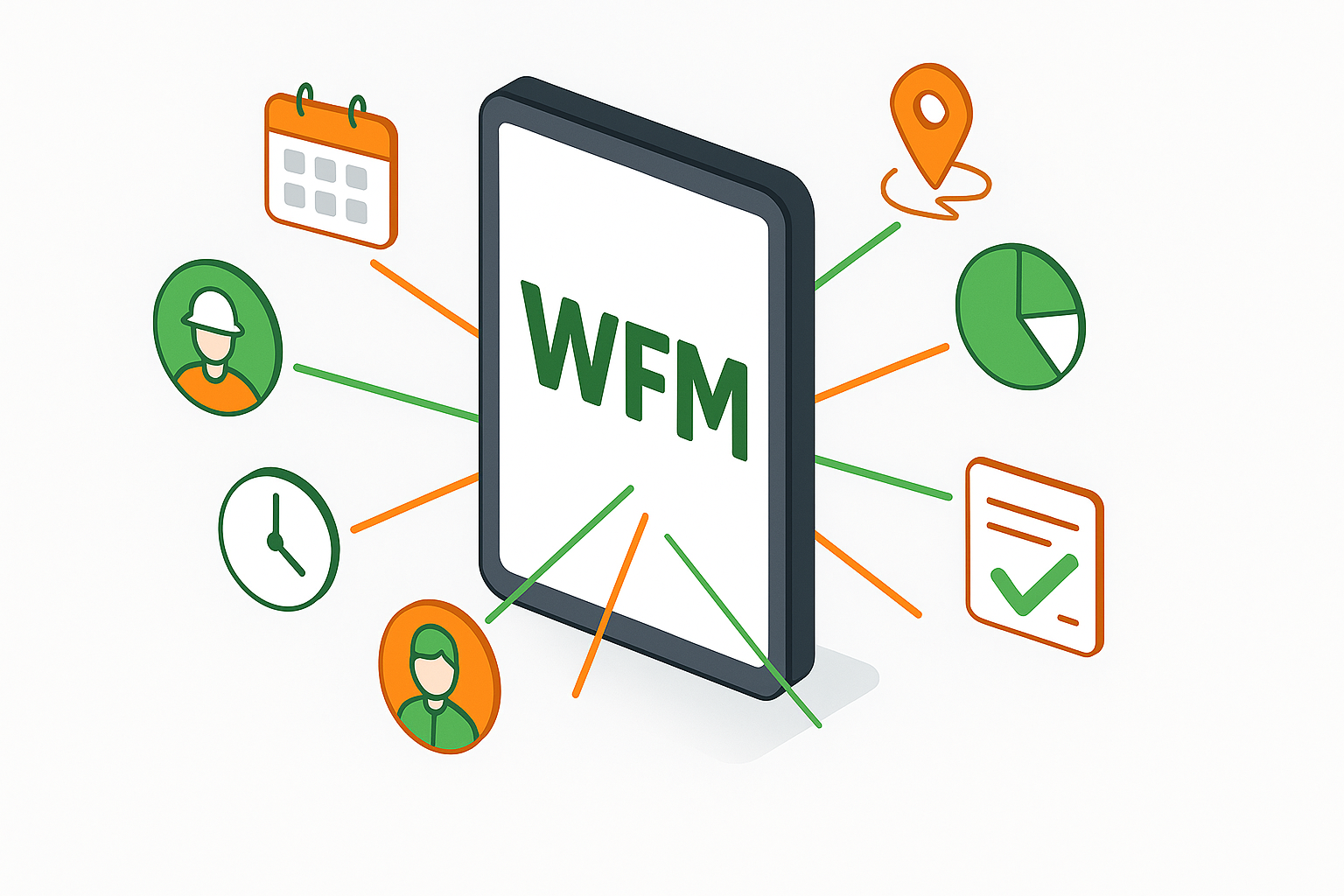
Assigning tasks is only part of managing field staff. Everything revolves around meeting deadlines, keeping operations on schedule, and making sure every interaction with customers goes smoothly. Organizational and managerial efficacy are key performance indicators for many companies, particularly those with mobile personnel, when looking at the company's long-term viability. What is workforce management, then? This method ensures that the correct people are doing the right things at the right times by providing a scientific framework for planning, scheduling, and measuring your team's daily operations. As a matter of fact, it makes it easier to merge multiple processes into one unified one. Everything from labor demand forecasting to real-time performance monitoring is encompassed in this idea, frequently abbreviated as WFM. There is more to grasping the WFM meaning than just HR theory. It's all about visibility, balance, and effective data utilization. Whether you manage technicians, cleaners, or delivery crews, good workforce management means your employees spend less time waiting and more time working. It better aligns employee capacity with customer demand, decreases idle time, and boosts overall productivity. In this article, we'll examine the workforce management definition, its primary components, and how current solutions, such as WFM software, may assist businesses in operating more quickly, accurately, and stress-free.

When asked ‘what is workforce management’, most often think of scheduling or timesheets. However, the picture is much broader. Workforce management encompasses planning, coordination, and performance in one process. It helps companies manage daily employee assignment, monitoring, and assistance.
Forecasting labor demand, optimizing resource use, and monitoring performance are workforce management definitions. Supervisors are advised of staffing needs, locations, and work performance.
WFM meaning transcends administrative management. It requires creating a balanced ecosystem where company demands match employee capabilities and expectations. Good workforce management improves operational efficiency, customer satisfaction, and fairness and transparency for all stakeholders. A well-structured workforce management system benefits all firms that rely on moving people, including service providers, retailers, healthcare providers, and logistics teams.
The importance of workforce management stems from the way it connects people, time, and production. Even powerful teams become inefficient when their schedules are disorganized or communication breaks down. WFM brings order to the chaos. It provides managers with total visibility into who is working, what is being done, and when tasks will be completed.
For companies with mobile or remote teams, workforce management serves as the foundation for operational control. It lowers downtime, improves communication, and enables teams to deliver consistent service quality. When your team works together as one integrated system, efficiency becomes a habit rather than an accident.
Every modern company depends on three essentials: people, time, and information. Together, they define how efficiently work gets done. Workforce management brings these elements under one system — connecting planning, execution, and reporting into a single workflow.
A clear definition of workforce management includes more than just scheduling tools; it covers every process that helps a business allocate resources, track progress, and evaluate performance. In practice, a complete WFM system turns scattered data into actionable insight. Below are the key components that make workforce management effective in daily operations.
When it comes to workforce management, scheduling is where I start. Consequently, it guarantees that every shift is covered, that every task is assigned to a person, and that no resource is wasted.
Management is able to construct schedules automatically with the use of advanced WFM software, which takes into consideration the abilities, location, and availability of employees.
In the event that your technician completes a task ahead of schedule, for instance, the system is able to immediately allocate the subsequent nearby task, thereby saving both time and gasoline. Through the distribution of tasks among the members of the team, smart scheduling also helps to avoid overloads. When planning is done in a proactive rather than reactive manner, businesses experience a reduction in the number of missed appointments and an increase in productivity.
The process of measuring time involves more than simply counting the hours; rather, it is about recognizing trends. The time that employees begin and end their work, the amount of time that each task takes, and the areas in which inefficiencies occur are all recorded by a competent WFM platform. These insights allow management to discover delays early and take corrective action before they harm customers.
Having accurate attendance data not only helps with payroll compliance and accuracy, but it also helps reduce the need for human corrections. Tracking that is allowed by GPS provides mobile or field-based teams with the ability to see when and where each work is finished. This provides an additional layer of transparency that helps to create confidence on both sides.
As a result of the utilization of data, personnel management is transformed from regular scheduling into strategic planning. Reporting on a regular basis helps measure results, not only in terms of what was accomplished but also in terms of how successfully it was accomplished. Managers are able to compare the work that was planned to the work that was performed, track individual key performance indicators, and reward outstanding performers when they have integrated dashboards.
The importance of workforce management in day-to-day operations is further highlighted by this visibility. Decision-making has the potential to become both more accurate and more expedient when data is centralized. The managers make the decision to stop guessing and begin improving. This process is automated by modern WFM software, which generates reports in a matter of seconds and frees up leadership to concentrate on issues that are genuinely responsible for driving performance, namely people and strategy.

When it comes to efficiency, manual scheduling and paper-based reporting can only carry a company so far. Guesswork is replaced with clarity by the use of WFM software. It integrates all aspects of the workforce cycle, including forecasting, scheduling, tracking, and evaluation, into a single digital ecosystem.
It is no longer necessary for managers to move between spreadsheets, texts, and phone calls due to the implementation of workforce management software in an organization. All data is stored in one place, accessible from the office or field. This level of visibility makes it less likely that people will misunderstand things, makes people more responsible, and speeds up the process of making decisions. Planado and other modern tools make it easy to sync job assignments and field updates right away. This makes sure that everyone is on the same page without any extra work.
WFM software should make complicated tasks easier. Key qualities are:
The size, mobility, and aims of your team will all influence the strategy you choose. Begin by determining where time and resources are being lost. Do you experience scheduling problems, a lack of visibility, or inconsistent reporting? The greatest WFM software should directly address these difficulties.
Look for platforms that provide:

When structure and insight come together, the real benefits of workforce management show up. It's not just about saving money or filling up schedules; it's about making sure that everyone, every job, and every resource works together. With modern WFM software, businesses can better predict needs, respond more quickly, and create a culture that is more productive.
The most visible outcome of a strong workforce management system is efficiency. When scheduling, tracking, and reporting happen automatically, teams save hours every week. Managers no longer spend time fixing overlaps or reassigning missed jobs.
With Planado, for instance, dispatchers instantly see which field worker is available nearby and can assign new tasks within seconds. Less idle time, fewer errors, and smarter routes directly translate into measurable cost reduction — all while keeping productivity at its peak.
Uncertainty regarding who is responsible for what and when is eliminated through the use of digital communication tools and clear scheduling. Every technician is aware of their responsibilities, is able to provide instant updates on the status of their work, and is aware of how their work contributes to the overall success of the organization. Both trust and motivation are increased as a result of this level of transparency. The fact that their efforts are reflected in the system and that their work is evaluated in a fair manner is something that employees appreciate.
The people in charge of the workers make decisions based on evidence. There is a pool of information that shows trends over time. Each completed project, delay, or customer review adds to that pool of knowledge. Executives can identify where productivity drops, who needs support, and which services give the best return on investment by using the built-in data and statistics. You don't have to guess anymore. The strength of WFM software is that it gives you facts instead of merely guesses, which helps you plan with confidence.
If you’re ready to see how smarter planning can simplify your daily operations, explore how workforce management tools like Planado bring clarity to every step — from scheduling to reporting. Discover how much time and energy your business can save when everything runs in one connected system.

Technology has transformed the way teams are planned, organized, and managed. People used to utilize spreadsheets and phone calls to complete tasks, but now they use automation, data, and mobile. Every decision, from who does the task to how the outcomes are delivered, may be made more quickly and correctly.
Companies now have more control over their operations because they use digital technologies rather than manual coordination. Modern WFM software allows managers and field workers to communicate in real time, making it easier to assess how well activities are progressing and make decisions based on that information. Companies do not have to cope with problems; instead, they can anticipate and prevent them.
Planado and other solutions advance this transformation even further. They enable field service teams to stay in touch from wherever by swiftly communicating plans, updates, and performance metrics. This means that developing businesses may devote more time to getting things done rather than dealing with them.
Field service work is inherently difficult. Jobs and schedules fluctuate throughout the day, and supervisors must be aware of what is going on at the site. Planado integrates all of these moving aspects into a single, user-friendly framework. This is an excellent example of how contemporary WFM software may improve management efficiency.
The web dashboard allows dispatchers to assign assignments, track progress, and adjust schedules in real time. The mobile app allows field workers to view their assignments, mark job phases, and provide photo reports. Everything is delivered to the workplace right away. Every update is provided in real time, allowing managers to make decisions based on facts rather than assumptions.
Planado is unusual in that it strikes an appropriate balance between automation and clarity. It eliminates all of the various chats, calls, and spreadsheets, replacing them with a single dependable procedure. The end result is less downtime, faster response to urgent jobs, and consistent service quality across the team.
Planado transforms field coordination into a competitive advantage for service businesses seeking to expand. It demonstrates in real statistics the true benefits of effective personnel management.
Understanding workforce management means knowing how structure can create freedom. When schedules, data, and communication are all in sync, businesses can grow without losing control. Modern WFM software makes that balance possible by replacing manual work with speed and clarity.
Planado and other tools show that even the hardest field tasks can be handled easily. Businesses can cut down on waste, improve quality, and keep customers happy by bringing together people and processes in real time.
It's time to make things easier if your employees are spending more time organizing than working. Start looking into how Planado might help you manage your employees more efficiently and give you measurable results right away.
What does WFM mean? WFM stands for workforce management — the process of planning, scheduling, and monitoring employee activities to improve efficiency and service quality. In field service industries, it helps ensure the right technician arrives at the right job at the right time, reducing costs and delays.
What are the roles and responsibilities of WFM? The main responsibilities of workforce management include scheduling jobs, tracking employee performance, forecasting demand, and maintaining compliance. Managers use WFM tools to coordinate field teams, assign tasks efficiently, and monitor results in real time.
How does WFM handle scheduling? WFM software automates scheduling by matching available technicians with open jobs based on skills, location, and workload. This ensures even task distribution and helps companies prevent overtime or missed appointments.
What are the benefits of workforce management software? Using workforce management software improves productivity, transparency, and customer satisfaction. It provides real-time visibility into field operations, reduces administrative work, and helps businesses make smarter, data-driven decisions.
